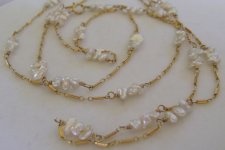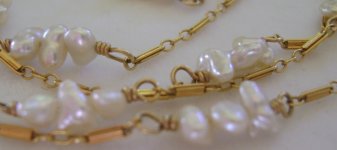Hi all,
I'm having an identification problem with an antique pearl necklace. I have just spoken with the lab gemologist, who tells me these are saltwater "keshi" pearls and must be classified as cultured. However, based on everything I know, this necklace dates from ca. 1910, unaltered, before any "keshi" industry was in existence.
There are 22 groups of 3 pearls here, separated by 14K gold bars and links. No thread was used; the pearls are linked by gold wire. The spring ring clasp is not modern. The gold bar links have a fine engraved design and appear to be stamped out, but the wire work around them and throughout the necklace done by hand.
After a gentle cleaning there is still tarnish visible (although perhaps not in my photo) between the wire and bars, and this tarnish is very dark brown, consistent with the estimated age of the necklace.
The necklace is 35" long -- again, a popular and appropriate length for this type of necklace circa 1910.
Taking the organic shapes into consideration, these pearls are very well matched. There is much more silver tone than shows in my photo, and the luster and orient are beautiful but not flashy, unlike modern keshi pearls I have seen.
The lab says that over half the pearls in the necklace exhibit interior voids. However, they also acknowledge that the pearls are larger than the normal keshi range.
It is my understanding that voids in pearls may be natural, or the result of tissue nucleation, or when the mollusk expels a bead and a keshi pearl forms.
I know that there are many on this forum who have much more knowledge about pearl critter biology than I do. I would be very grateful for any insights you have. Also, I intend to send this necklace out for a second opinion, and would like to ask who would be the best person to contact?
I'm having an identification problem with an antique pearl necklace. I have just spoken with the lab gemologist, who tells me these are saltwater "keshi" pearls and must be classified as cultured. However, based on everything I know, this necklace dates from ca. 1910, unaltered, before any "keshi" industry was in existence.
There are 22 groups of 3 pearls here, separated by 14K gold bars and links. No thread was used; the pearls are linked by gold wire. The spring ring clasp is not modern. The gold bar links have a fine engraved design and appear to be stamped out, but the wire work around them and throughout the necklace done by hand.
After a gentle cleaning there is still tarnish visible (although perhaps not in my photo) between the wire and bars, and this tarnish is very dark brown, consistent with the estimated age of the necklace.
The necklace is 35" long -- again, a popular and appropriate length for this type of necklace circa 1910.
Taking the organic shapes into consideration, these pearls are very well matched. There is much more silver tone than shows in my photo, and the luster and orient are beautiful but not flashy, unlike modern keshi pearls I have seen.
The lab says that over half the pearls in the necklace exhibit interior voids. However, they also acknowledge that the pearls are larger than the normal keshi range.
It is my understanding that voids in pearls may be natural, or the result of tissue nucleation, or when the mollusk expels a bead and a keshi pearl forms.
I know that there are many on this forum who have much more knowledge about pearl critter biology than I do. I would be very grateful for any insights you have. Also, I intend to send this necklace out for a second opinion, and would like to ask who would be the best person to contact?


